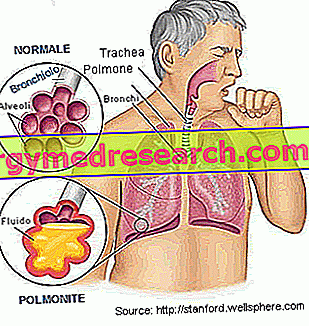Generality
Pneumonia is an inflammatory process that affects one or both lungs.
Causes
Generally, pneumonia is caused by bacterial, viral or more rarely fungal infections.

Subject to Risk
The chances of getting sick depend on the health of the host and are generally above two years of age and above 65.
Symptoms
In response to phlogosis the lungs fill with a biological fluid that compromises normal respiratory function, with the appearance of dyspnea (air hunger).
In addition to breathing difficulties, pneumonia symptoms often follow those of a trivial flu, with cough, general malaise and sometimes fever.
Diagnosis and Treatment
The diagnosis of pneumonia is made by examining chest radiographs, symptoms and sometimes the patient's sputum.
Medical treatment depends on the causes of the disease; in bacterial pneumonia, for example, antibiotics are used, while in viral ones simple rest is often sufficient for a few days.
Prevention
Preventive measures include the careful washing of hands, abstaining from smoking and the use of masks to avoid contact with polluting or highly irritating agents. Special vaccines are also available to prevent some forms of infectious pneumonia, such as the flu and pneumococcal ones.
Insights
Pneumonia Symptoms Pneumonia Causes Bacterial Pneumonia Viral Pneumonia Micoplasmic Pneumonia Other Forms of Pneumonia Risk Factors Pneumonia Diagnosis Care and TreatmentSymptoms
To learn more: Symptoms Asthma
The symptoms of pneumonia can vary, even significantly, depending on the patient's general state of health and the organism responsible for the infection. In milder cases, pneumonia follows the typical symptoms of influenza, beginning with a little cough and low-grade fever. Other typical symptoms of this disease are the aforementioned dyspnea (shortness of breath), sweating, chills, headache, muscle pain and the unpleasant feeling of general malaise. If the inflammatory process extends to the superficial areas of the lung, with involvement of the pleura (pleuritis), the patient complains of chest pain, accentuated by deep inspiration, coughing and chest movements. Due to the insufficient immune response, individuals at high risk of complications tend to develop milder onset symptoms, making this disease even more insidious and dangerous. Not by chance, pneumonia is often used as an example of diseases with atypical symptoms in old age.
Causes
Under normal conditions, various defensive mechanisms protect the body from lung infections. This is the case, for example, of nostril hairs, coughs, but also cilia and bronchial mucus. When pathogens can overcome these defenses and reach the pulmonary alveoli, they are readily attacked by white blood cells. The consequent inflammatory process leads to the accumulation of a liquid rich in proteins, called exudate, which fills the alveoli opposing the normal exchange of respiratory gases. Furthermore, this fluid acts as a culture medium for bacteria and facilitates their dissemination to nearby alveoli.
Pneumonia can be caused not only by bacteria, but also by viruses, mycoplasmas, fungi and various chemicals. Pathogenic microorganisms can reach the tracheobronchial tree through four ways:
- by inhalation (pathogens contained in aerosol droplets small enough to reach the alveoli);
- by aspiration (entry of foreign materials into the bronchial tree - usually represented by food residues, saliva or nasal secretions - which can act as a vehicle for the microbes responsible for pneumonia);
- by direct inoculation from adjacent sites;
- for hematogenous or lymphatic diffusion.
Predisposing factors:
- Extreme age classes
- Poor socioeconomic conditions
- Chronic debilitating diseases, diabetes
- Renal and cardiac failure
- Hospitalization
- Etilism, smoking
- Air pollution
- Infections of the upper airways
- immunosuppression
- Prolonged therapy with
immunosuppressants such as corticosteroids
- Chemotherapy
- Poor oral hygiene
- Dysphagia, altered state of consciousness
When to consult a doctor
Since pneumonia can become particularly dangerous for the patient's health, in the presence of shortness of breath, tachycardia, cyanosis, hemoptysis, chest pain, persistent cough, high fever (especially if associated with chills and sweating) or sudden worsening of one's health conditions after a cold or flu, it is good to immediately contact your doctor, especially when the aforementioned risk factors exist.
Among those listed, the most frequent mechanisms are inhalation and aspiration.
Bacterial Pneumonia
Bacterial pneumonias can affect anyone, at any age, but prefer debilitated individuals, alcoholics and people who present the other risk factors listed in the table. They are the most common cause of pneumonia in adults over 30 years old.
Some germs responsible for bacterial pneumonia are commonly found in the oral cavity and in the first airways of healthy people. Taking advantage of a decline in defenses or other predisposing factors, these germs can descend the bronchial tree until they reach the alveoli. Here, the immune response determines the accumulation of fluids, which prevent the normal exchange of gas between the blood and the inspired air.
The infection can remain confined or extend to the entire lung; in the most severe cases, in addition, bacteria can enter the bloodstream and affect the entire body, causing very serious or even fatal diseases.
Among the bacteria, Streptococcus pneumoniae, responsible for pneumococcal pneumonia, is the most frequent responsible for home pneumonia in all age groups except for children. In this case the disease can be prevented by undergoing a specific vaccination (see: Prevenar - Synflorix).
Among the other infectious agents of bacterial origin, Gram positive, we mention Staphylococcus aureus and Streptococcus agalactiae (responsible for pneumonia in infancy), while among the Gram negative ones there are Haemophilus influenzae, Klebsiella pneumoniae, Pseudomonas aeruginosa, Escherichia coli and other Enterobacteriaceae .



